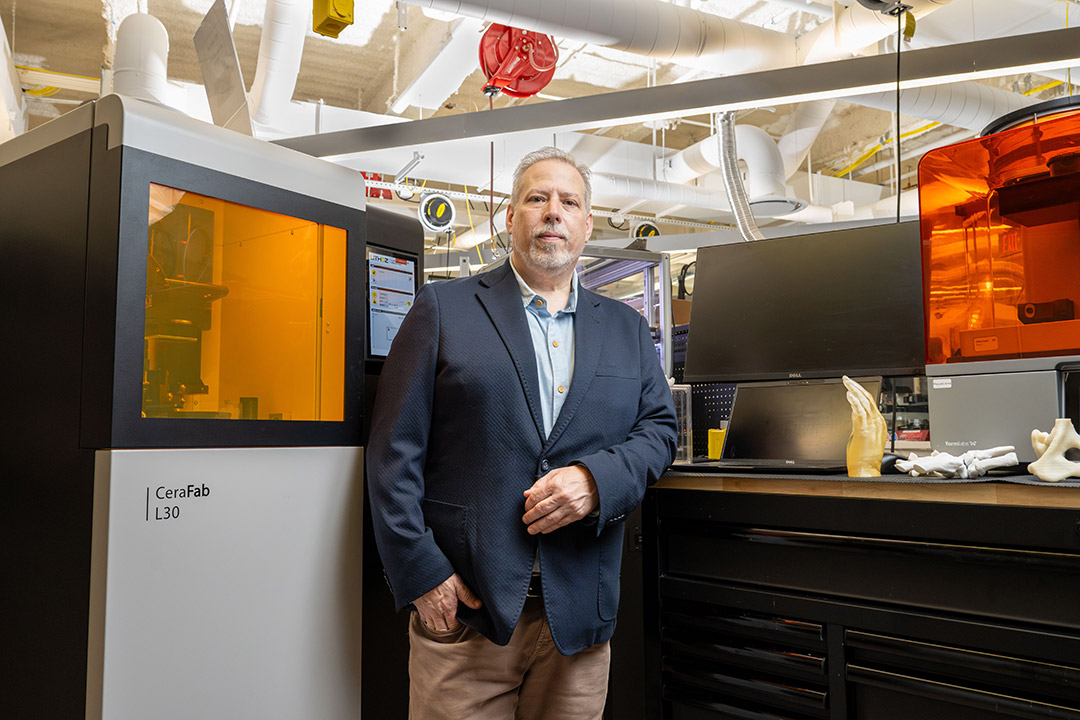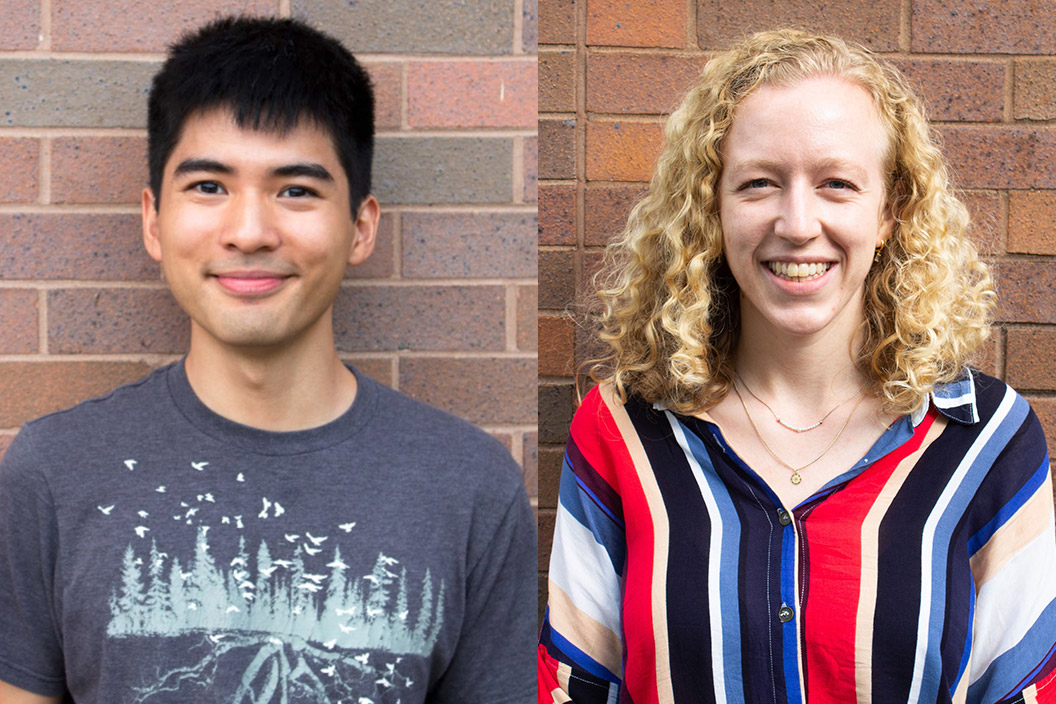RIT offers occupational therapy clinical doctorate degree in 2026
Rochester Institute of Technology’s newest doctoral degree offers a personalized approach to helping people with illnesses or disabilities participate in life. An entry-level clinical doctorate in occupational therapy (OTD) will launch in June 2026. The program will focus on innovative interventions and adaptive devices that extend patients’ functional skills. The OTD program represents the university’s first clinical doctorate degree.
Pete Schuck/RIT RIT’s clinical doctorate in occupational therapy looks to the future of adaptive design. Here, Christopher Alterio, OTD director, and Marcia Shea, OTD clinical coordinator, tour the AMPrint Center and learn about integrated prosthetic research that could revolutionize occupational therapy.
“Occupational therapy is about function, participation, and adaptation,” said Christopher Alterio, director of RIT’s occupational therapy doctoral program. “Occupational therapists work across a variety of different settings and diagnoses, helping people do the things they need and want to do in the context of their real lives.” The future-facing and collaborative program will develop clinicians who are comfortable working with engineers, designers, and data scientists to create meaningful solutions for people, he said. “Our students will work in AR/VR environments and design custom orthotics and prosthetics in 3D-printing labs,” Alterio said. “They will learn how to evaluate emerging tools that are still being tested in research settings.” The three-year clinical doctorate, approved by the Accreditation Council for Occupational Therapy Education and the New York State Education Department, is housed within RIT’s Wegmans School of Health and Nutrition. The program will prepare graduates to work with people of all ages at schools, hospitals, and outpatient clinics. The program consists of nine consecutive semesters, a capstone, and required fieldwork, and blends a traditional curriculum with innovative technology and experiential learning. Completion of the program qualifies graduates to sit for the national certification exam administered by the National Board for Certification in Occupational Therapy. U.S. News Careers ranks occupational therapy as the eighth best health care career in 2025. Increased retirement rates within the profession create opportunities for the next generation to bring new energy to the field. The U.S. Bureau of Labor Statistics projects the need for occupational therapists to grow by 11 percent through 2033 and reports a median annual wage of $98,340. The expansion of RIT’s health sciences programs will help address workforce shortages in the health sector, starting with occupational therapy, according to Yong “Tai” Wang, dean of RIT’s College of Health Sciences and Technology. OTD’s focus on patient experience and capstone research distinguishes it from RIT’s 13 Ph.D. programs. “Healthcare workforce demands present an opportunity for RIT to make an impact beyond the region,” Wang said. “Our OTD program will educate a new type of clinician who approaches patient-centered care with a technology mindset.” The OTD lab will give students experience working in augmented- and virtual-reality (AR/VR) spaces for immersive rehabilitation, traditional outpatient therapy environments, and a large pediatric play space. Occupational therapy at RIT will tap into the synergy of technology, the arts, and design on campus, Alterio said, and explore possibilities through AR/VR simulations, personalized 3D-printed prostheses, and apps that gamify OT. Close proximity to research labs, studios, and makerspaces across campus gives the OTD program an edge, Alterio said. Occupational therapy is a multidisciplinary field with overlap in health sciences, engineering, computer science, and industrial design, among other areas. Researchers at RIT’s AMPrint Center, for instance, develop and test additive manufacturing and 3D-printing technologies and materials. Ongoing research in 3D-printed orthotics and personalized prosthesis technology integrated with tissue engineering has OT applications. Accessible design challenges, such as RIT’s Studio 930, give students other opportunities to work in multidisciplinary teams and apply design thinking to real problems. OTD students can gain experience interacting with clients representing the Al Sigl Community of Agencies and the RIT-Rochester Regional Health Alliance, a strategic partnership between the university and the health system. “We want to make it the norm in occupational therapy to work with people who are always advancing technology,” Alterio said. “I want to model a spirit of collaboration so we can bring the kinds of amazing ideas that are happening on campus into the field and directly to patients.” For more information about RIT’s OTD program, contact Alterio at cjachst@rit.edu.
 RIT offers occupational therapy clinical doctorate degree in 2026Rochester Institute of Technology’s newest doctoral degree offers a personalized approach to helping people with illnesses or disabilities participate in life. An entry-level clinical doctorate in occupational therapy (OTD) will launch in June 2026. The program will focus on innovative interventions and adaptive devices that extend patients’ functional skills. The OTD program represents the university’s first clinical doctorate degree. Pete Schuck/RIT RIT’s clinical doctorate in occupational therapy looks to the future of adaptive design. Here, Christopher Alterio, OTD director, and Marcia Shea, OTD clinical coordinator, tour the AMPrint Center and learn about integrated prosthetic research that could revolutionize occupational therapy. “Occupational therapy is about function, participation, and adaptation,” said Christopher Alterio, director of RIT’s occupational therapy doctoral program. “Occupational therapists work across a variety of different settings and diagnoses, helping people do the things they need and want to do in the context of their real lives.” The future-facing and collaborative program will develop clinicians who are comfortable working with engineers, designers, and data scientists to create meaningful solutions for people, he said. “Our students will work in AR/VR environments and design custom orthotics and prosthetics in 3D-printing labs,” Alterio said. “They will learn how to evaluate emerging tools that are still being tested in research settings.” The three-year clinical doctorate, approved by the Accreditation Council for Occupational Therapy Education and the New York State Education Department, is housed within RIT’s Wegmans School of Health and Nutrition. The program will prepare graduates to work with people of all ages at schools, hospitals, and outpatient clinics. The program consists of nine consecutive semesters, a capstone, and required fieldwork, and blends a traditional curriculum with innovative technology and experiential learning. Completion of the program qualifies graduates to sit for the national certification exam administered by the National Board for Certification in Occupational Therapy. U.S. News Careers ranks occupational therapy as the eighth best health care career in 2025. Increased retirement rates within the profession create opportunities for the next generation to bring new energy to the field. The U.S. Bureau of Labor Statistics projects the need for occupational therapists to grow by 11 percent through 2033 and reports a median annual wage of $98,340. The expansion of RIT’s health sciences programs will help address workforce shortages in the health sector, starting with occupational therapy, according to Yong “Tai” Wang, dean of RIT’s College of Health Sciences and Technology. OTD’s focus on patient experience and capstone research distinguishes it from RIT’s 13 Ph.D. programs. “Healthcare workforce demands present an opportunity for RIT to make an impact beyond the region,” Wang said. “Our OTD program will educate a new type of clinician who approaches patient-centered care with a technology mindset.” The OTD lab will give students experience working in augmented- and virtual-reality (AR/VR) spaces for immersive rehabilitation, traditional outpatient therapy environments, and a large pediatric play space. Occupational therapy at RIT will tap into the synergy of technology, the arts, and design on campus, Alterio said, and explore possibilities through AR/VR simulations, personalized 3D-printed prostheses, and apps that gamify OT. Close proximity to research labs, studios, and makerspaces across campus gives the OTD program an edge, Alterio said. Occupational therapy is a multidisciplinary field with overlap in health sciences, engineering, computer science, and industrial design, among other areas. Researchers at RIT’s AMPrint Center, for instance, develop and test additive manufacturing and 3D-printing technologies and materials. Ongoing research in 3D-printed orthotics and personalized prosthesis technology integrated with tissue engineering has OT applications. Accessible design challenges, such as RIT’s Studio 930, give students other opportunities to work in multidisciplinary teams and apply design thinking to real problems. OTD students can gain experience interacting with clients representing the Al Sigl Community of Agencies and the RIT-Rochester Regional Health Alliance, a strategic partnership between the university and the health system. “We want to make it the norm in occupational therapy to work with people who are always advancing technology,” Alterio said. “I want to model a spirit of collaboration so we can bring the kinds of amazing ideas that are happening on campus into the field and directly to patients.” For more information about RIT’s OTD program, contact Alterio at cjachst@rit.edu.
RIT offers occupational therapy clinical doctorate degree in 2026Rochester Institute of Technology’s newest doctoral degree offers a personalized approach to helping people with illnesses or disabilities participate in life. An entry-level clinical doctorate in occupational therapy (OTD) will launch in June 2026. The program will focus on innovative interventions and adaptive devices that extend patients’ functional skills. The OTD program represents the university’s first clinical doctorate degree. Pete Schuck/RIT RIT’s clinical doctorate in occupational therapy looks to the future of adaptive design. Here, Christopher Alterio, OTD director, and Marcia Shea, OTD clinical coordinator, tour the AMPrint Center and learn about integrated prosthetic research that could revolutionize occupational therapy. “Occupational therapy is about function, participation, and adaptation,” said Christopher Alterio, director of RIT’s occupational therapy doctoral program. “Occupational therapists work across a variety of different settings and diagnoses, helping people do the things they need and want to do in the context of their real lives.” The future-facing and collaborative program will develop clinicians who are comfortable working with engineers, designers, and data scientists to create meaningful solutions for people, he said. “Our students will work in AR/VR environments and design custom orthotics and prosthetics in 3D-printing labs,” Alterio said. “They will learn how to evaluate emerging tools that are still being tested in research settings.” The three-year clinical doctorate, approved by the Accreditation Council for Occupational Therapy Education and the New York State Education Department, is housed within RIT’s Wegmans School of Health and Nutrition. The program will prepare graduates to work with people of all ages at schools, hospitals, and outpatient clinics. The program consists of nine consecutive semesters, a capstone, and required fieldwork, and blends a traditional curriculum with innovative technology and experiential learning. Completion of the program qualifies graduates to sit for the national certification exam administered by the National Board for Certification in Occupational Therapy. U.S. News Careers ranks occupational therapy as the eighth best health care career in 2025. Increased retirement rates within the profession create opportunities for the next generation to bring new energy to the field. The U.S. Bureau of Labor Statistics projects the need for occupational therapists to grow by 11 percent through 2033 and reports a median annual wage of $98,340. The expansion of RIT’s health sciences programs will help address workforce shortages in the health sector, starting with occupational therapy, according to Yong “Tai” Wang, dean of RIT’s College of Health Sciences and Technology. OTD’s focus on patient experience and capstone research distinguishes it from RIT’s 13 Ph.D. programs. “Healthcare workforce demands present an opportunity for RIT to make an impact beyond the region,” Wang said. “Our OTD program will educate a new type of clinician who approaches patient-centered care with a technology mindset.” The OTD lab will give students experience working in augmented- and virtual-reality (AR/VR) spaces for immersive rehabilitation, traditional outpatient therapy environments, and a large pediatric play space. Occupational therapy at RIT will tap into the synergy of technology, the arts, and design on campus, Alterio said, and explore possibilities through AR/VR simulations, personalized 3D-printed prostheses, and apps that gamify OT. Close proximity to research labs, studios, and makerspaces across campus gives the OTD program an edge, Alterio said. Occupational therapy is a multidisciplinary field with overlap in health sciences, engineering, computer science, and industrial design, among other areas. Researchers at RIT’s AMPrint Center, for instance, develop and test additive manufacturing and 3D-printing technologies and materials. Ongoing research in 3D-printed orthotics and personalized prosthesis technology integrated with tissue engineering has OT applications. Accessible design challenges, such as RIT’s Studio 930, give students other opportunities to work in multidisciplinary teams and apply design thinking to real problems. OTD students can gain experience interacting with clients representing the Al Sigl Community of Agencies and the RIT-Rochester Regional Health Alliance, a strategic partnership between the university and the health system. “We want to make it the norm in occupational therapy to work with people who are always advancing technology,” Alterio said. “I want to model a spirit of collaboration so we can bring the kinds of amazing ideas that are happening on campus into the field and directly to patients.” For more information about RIT’s OTD program, contact Alterio at cjachst@rit.edu. Two students win competitive NASA awards for graduate researchStudents Allen Wen and Sadie Coffin wrote two of 24 proposals accepted in the astrophysics category out of 456 submissions. Wen, advised by Professor Yosef Zlochower from the School of Mathematics and Statistics, will be modeling multiwavelength signals from binary neutron star mergers. Coffin, under the direction of Associate Professor Jeyhan Kartaltepe from the School of Physics and Astronomy, will be leveraging citizen science measurements to efficiently identify galaxy pairs. FINESST awardees must be the primary author of the research and will receive $50,000 per year for up to three years. RIT is one of just two schools nationwide to have more than one FINESST proposal in astrophysics accepted, and those two are in two different research centers associated with the Ph.D. program: The Center for Computational Relativity and Gravitation and the Laboratory for Multiwavelength Astrophysics. “It speaks to the emphasis on excellence that we have in the program,” said Zlochower. “It’s unusual to get one student winning. Two is quite remarkable.” In 2017, the first binary neutron star merger that detected both gravitational waves and a light signal from the same event was observed. That left a lot of data to be analyzed and explained. Wen will be creating big simulations to try to answer why the light signal looked the way it did, what different things could be active at the sight of the merger, and how these events can impact the light signals we observe. He credits the entire research group with helping him prepare a successful proposal. “We have a very open and collaborative environment,” said Wen. “I could get help from other grad students, junior researchers, and professors and get all sorts of feedback. The collaboration helps in both writing this one proposal and in day-to-day research, as well.” Coffin is enlisting citizens to be trained and then to help comb through spectroscopic data to study galaxies through the Redshift Wrangler project. The project uses volunteer contributions to identify and analyze galaxy pairs at high redshift. Previous studies on galaxies have limited sample sizes, but using citizen science helps astronomers comb through data faster. “We have this problem that the spectra we have right now are somewhat manageable, but over the next several years, we’re going to be inundated because there will be a lot of instruments providing millions of spectra,” explained Kartaltepe. “Nobody will be able to look at every single object anymore. Projects like this where you can crowdsource some of the measurements can be really useful.” The FINESST funding for the project will also help bring real science to people around the world, hopefully growing an interest in the overall work and making high-level research available to anyone. “I’m really excited about making science more open,” said Coffin. “We welcome anyone to be a part of our scientific research. We benefit from diverse perspectives. It’s fun to see the different paths to studying these big questions about the universe.”
Two students win competitive NASA awards for graduate researchStudents Allen Wen and Sadie Coffin wrote two of 24 proposals accepted in the astrophysics category out of 456 submissions. Wen, advised by Professor Yosef Zlochower from the School of Mathematics and Statistics, will be modeling multiwavelength signals from binary neutron star mergers. Coffin, under the direction of Associate Professor Jeyhan Kartaltepe from the School of Physics and Astronomy, will be leveraging citizen science measurements to efficiently identify galaxy pairs. FINESST awardees must be the primary author of the research and will receive $50,000 per year for up to three years. RIT is one of just two schools nationwide to have more than one FINESST proposal in astrophysics accepted, and those two are in two different research centers associated with the Ph.D. program: The Center for Computational Relativity and Gravitation and the Laboratory for Multiwavelength Astrophysics. “It speaks to the emphasis on excellence that we have in the program,” said Zlochower. “It’s unusual to get one student winning. Two is quite remarkable.” In 2017, the first binary neutron star merger that detected both gravitational waves and a light signal from the same event was observed. That left a lot of data to be analyzed and explained. Wen will be creating big simulations to try to answer why the light signal looked the way it did, what different things could be active at the sight of the merger, and how these events can impact the light signals we observe. He credits the entire research group with helping him prepare a successful proposal. “We have a very open and collaborative environment,” said Wen. “I could get help from other grad students, junior researchers, and professors and get all sorts of feedback. The collaboration helps in both writing this one proposal and in day-to-day research, as well.” Coffin is enlisting citizens to be trained and then to help comb through spectroscopic data to study galaxies through the Redshift Wrangler project. The project uses volunteer contributions to identify and analyze galaxy pairs at high redshift. Previous studies on galaxies have limited sample sizes, but using citizen science helps astronomers comb through data faster. “We have this problem that the spectra we have right now are somewhat manageable, but over the next several years, we’re going to be inundated because there will be a lot of instruments providing millions of spectra,” explained Kartaltepe. “Nobody will be able to look at every single object anymore. Projects like this where you can crowdsource some of the measurements can be really useful.” The FINESST funding for the project will also help bring real science to people around the world, hopefully growing an interest in the overall work and making high-level research available to anyone. “I’m really excited about making science more open,” said Coffin. “We welcome anyone to be a part of our scientific research. We benefit from diverse perspectives. It’s fun to see the different paths to studying these big questions about the universe.” Men's tennis drops home match to conference rival UnionROCHESTER, NY - The RIT men's tennis team (3-4, 0-3 Liberty League) fell to Liberty League foe Union College (3-0, 2-0 Liberty League) from the Midtown Athletic Club Sunday afternoon. Union would win two of three doubles points. RIT's Brennan Bull and Jacob Meyerson earned RIT's lone doubles point in a great...
Men's tennis drops home match to conference rival UnionROCHESTER, NY - The RIT men's tennis team (3-4, 0-3 Liberty League) fell to Liberty League foe Union College (3-0, 2-0 Liberty League) from the Midtown Athletic Club Sunday afternoon. Union would win two of three doubles points. RIT's Brennan Bull and Jacob Meyerson earned RIT's lone doubles point in a great... Women's tennis suffers loss to Skidmore in Liberty League openerROCHESTER, NY - The RIT women's tennis team (4-2, 0-1 Liberty League) dropped its Liberty League Conference opener, 9-0 to defending champion Skidmore College (5-0, 4-0 Liberty League) from the Midtown Athletic Club Sunday afternoon. Skidmore would take the first three doubles points. At first doubles, Anne Taylor and Kristen Zablonski put...
Women's tennis suffers loss to Skidmore in Liberty League openerROCHESTER, NY - The RIT women's tennis team (4-2, 0-1 Liberty League) dropped its Liberty League Conference opener, 9-0 to defending champion Skidmore College (5-0, 4-0 Liberty League) from the Midtown Athletic Club Sunday afternoon. Skidmore would take the first three doubles points. At first doubles, Anne Taylor and Kristen Zablonski put...

